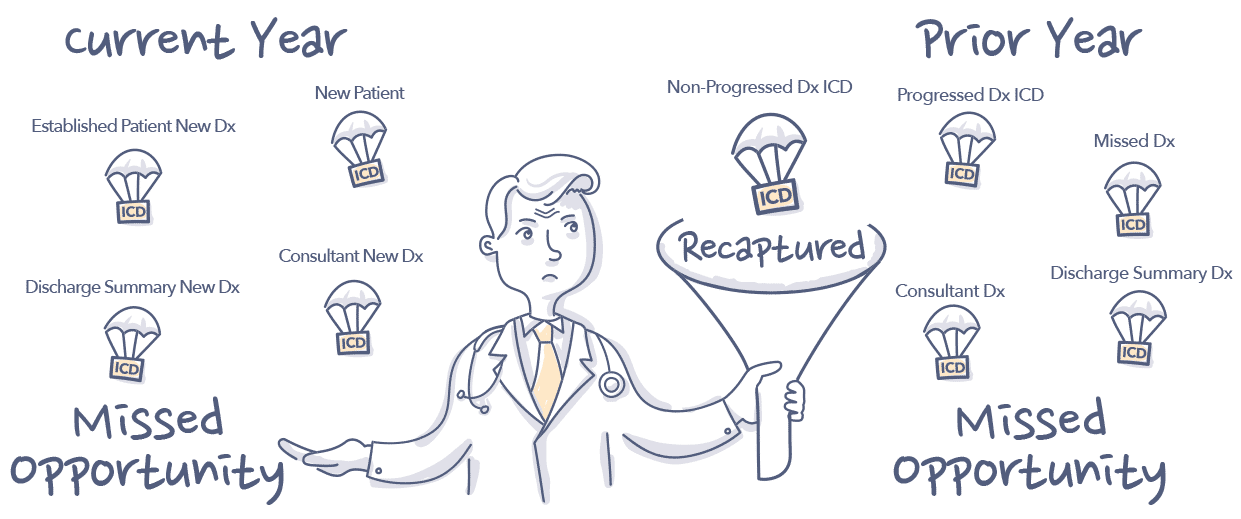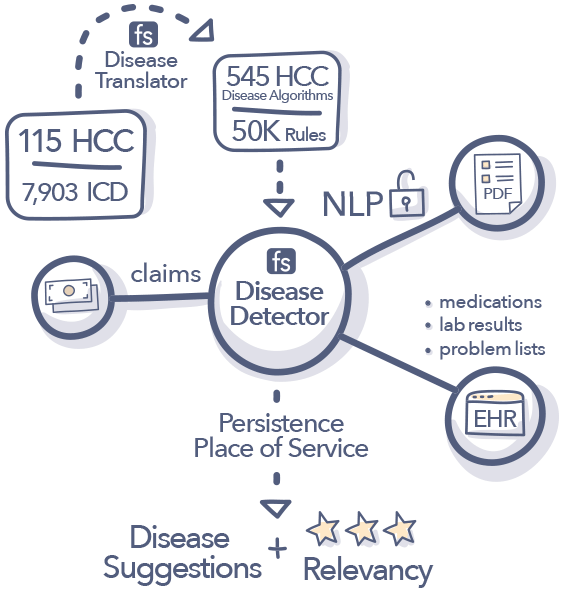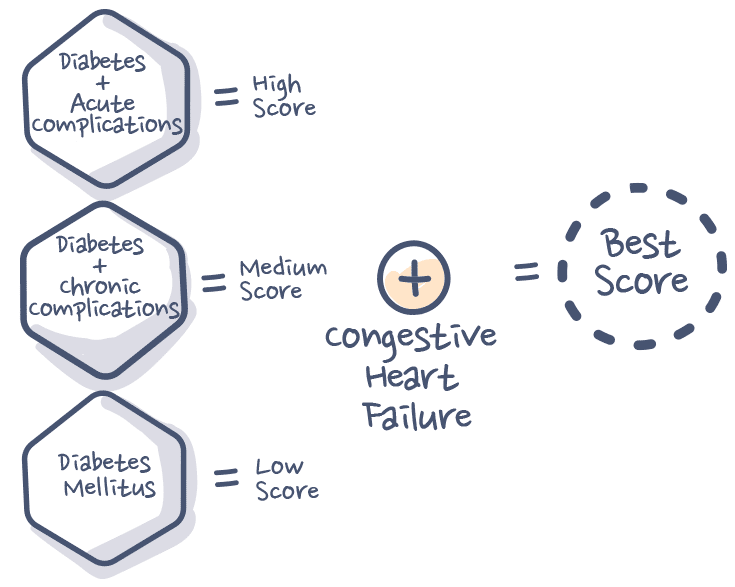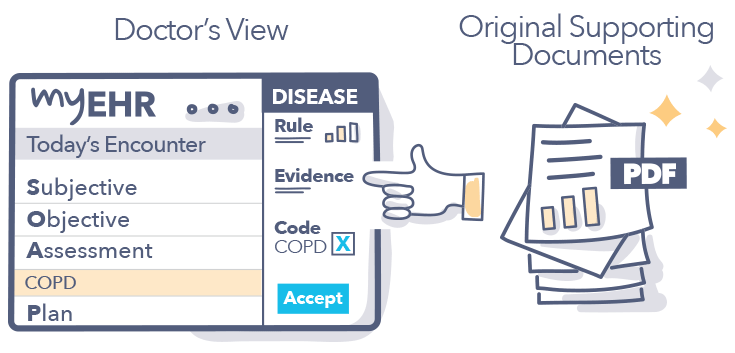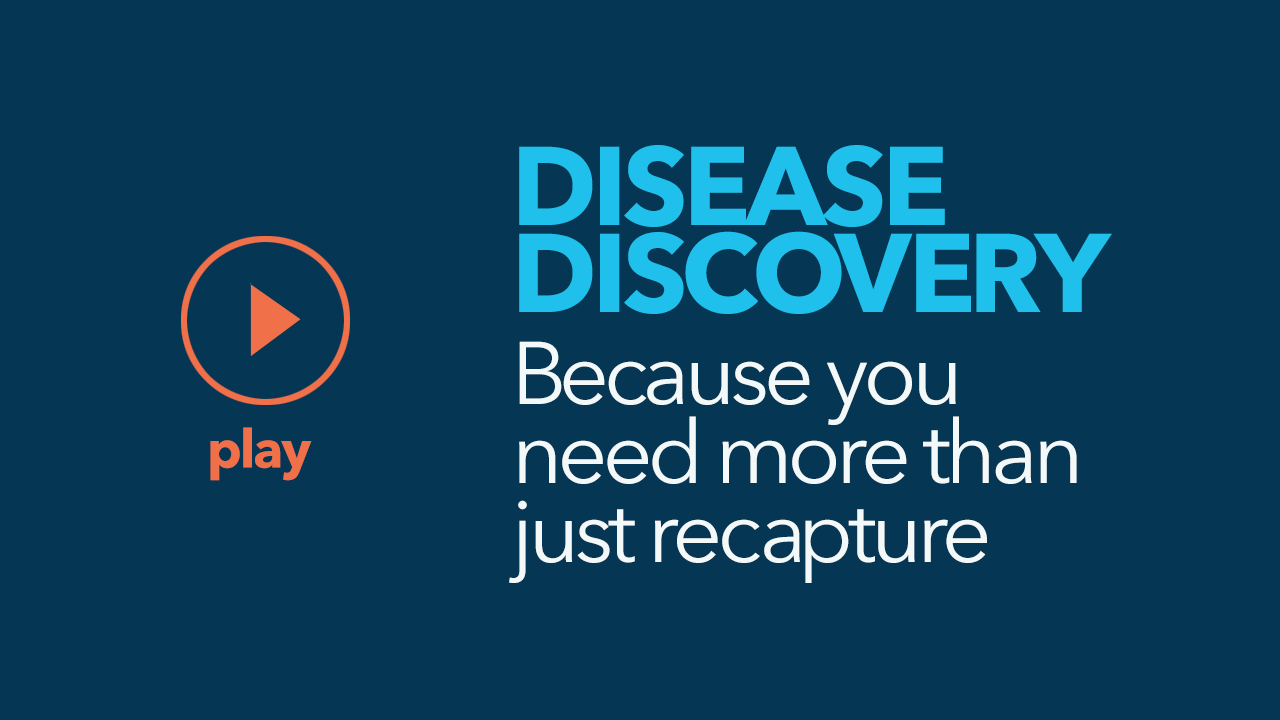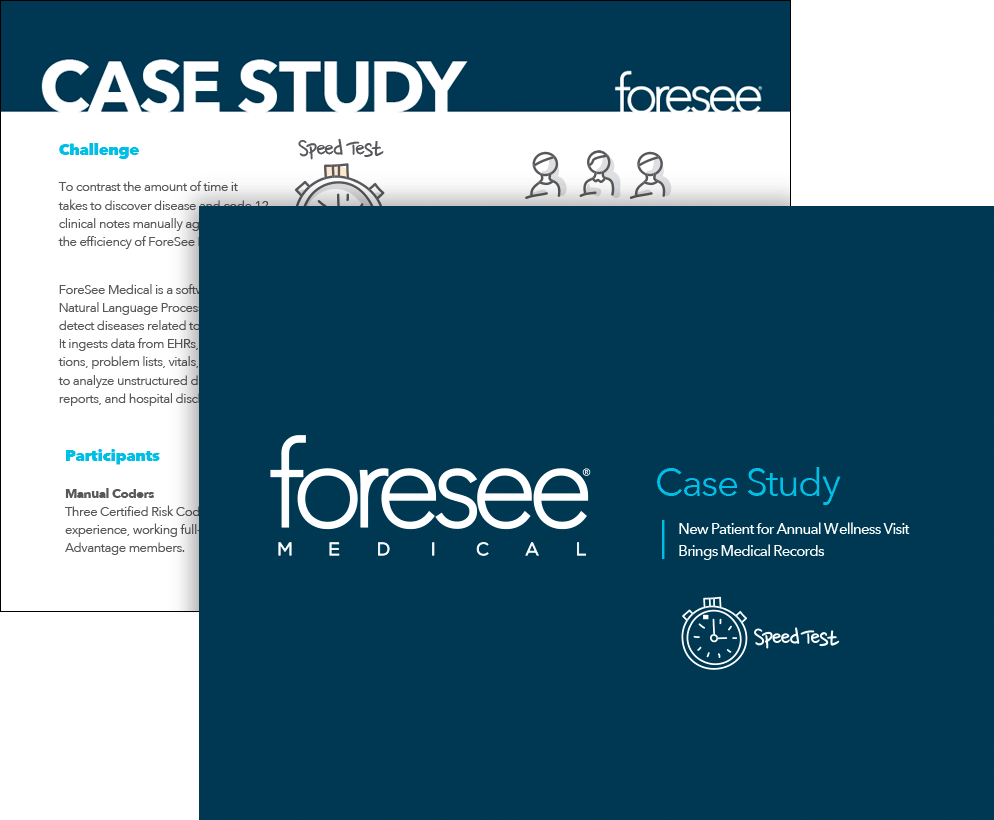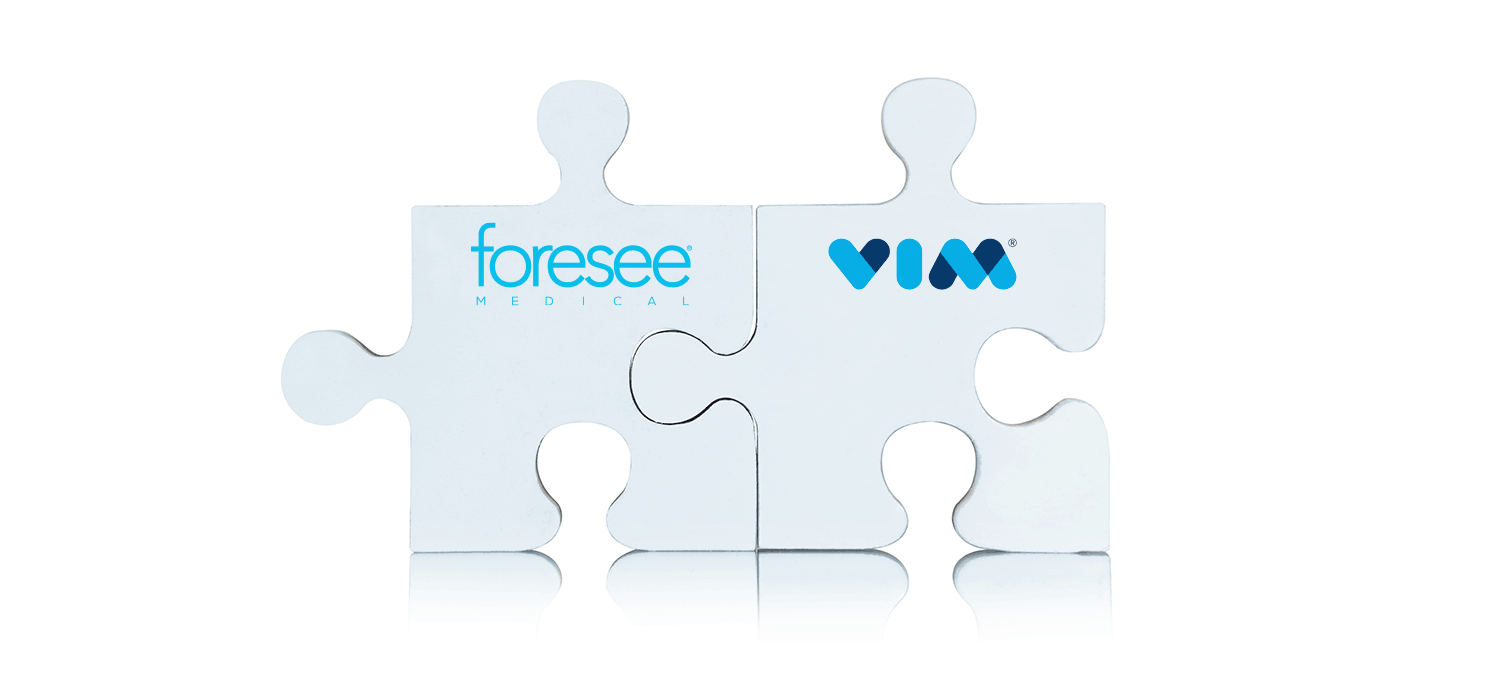HCC risk adjustment coding software
You work hard to serve complex populations. Boost your HCC coding accuracy with AI and get the reimbursements you deserve.
Disease Discovery, because…
You need more than just recapture
Relying on code recapture alone for HCC risk adjustment inevitably leads to missed RAF scoring opportunities and incomplete documentation. While many EHRs offer basic recapture tools, these solutions often fall short—especially for new patients or those with progressive conditions such as diabetes, where ongoing complexity is frequently overlooked.
ForeSee Medical’s advanced artificial intelligence goes far beyond recapture. Our disease discovery engine identifies conditions that traditional tools miss, surfacing new, clinically relevant suspects that drive accurate HCC coding. In fact, in one high-performing organization, disease discovery uncovered four times more new conditions than recapture alone during annual wellness visits—creating significant opportunities for RAF score improvement and optimized reimbursement (see our case studies).
For organizations engaged in value-based care, disease discovery isn’t just about revenue. It ensures risk adjustment coding is aligned with high-quality care, patient needs, and long-term financial sustainability.
“It finds everything and informs us whether we need to take action on it, and it doesn’t miss anything.”
“We chose ForeSee Medical because it uses natural language processing to scour the data and reveals all the data that’s relevant. And beyond that, it presents what hasn’t been reported yet this year. It’s an integral part of our workflow for Medicare Advantage patients. We can capture the health state of the patient with all of the data that ForeSee presents. It finds everything and informs us whether we need to take action on it, and it doesn’t miss anything. We now have time to do a thorough look at every patient, rather than just the last note.”
Jim Moore
Director of Operations, BeWell Clinic
Weslaco, TX
More Testimonials
A sample of EHRs we integrate with
it starts here
Disease concepts make your HCC coding easy
Your patients aren’t just HCC codes in a risk category, they’re people who have specific diseases. Our proprietary disease translator maps the 7,903 HCC ICDs to 545 disease concepts within the 115 HCC categories. Our disease detection algorithms are then matched against every patient's chart to accurately identify the patient’s disease burden. Since we know you think in terms of disease concepts, not codes and categories, our disease translator and detection algorithms make incorporating the HCC healthcare model into your risk adjustment easy.
unlock the data
We understand how you speak
You know that providers don’t all “speak the same way”, and we agree, so we built our natural language processing (NLP) engine on a machine learning platform to accommodate the wide variation of medical notation terminology. Your clinical notes (unstructured data) are “read” by our engine, it extracts the patient chart information, codifies it (structured data), and creates a longitudinal patient record.
in this case, we…
Don’t break the rules
As our HCC risk adjustment software processes your patient data, Risk Adjustment Rules - Hierarchies, Interactions and Counts are incorporated into scoring calculations. When the NLP engine processes clinical notes M.E.A.T. section headers are recognized and data extractions are weighted accordingly.
be amazing
You’re in control
A clinical decision support message appears when data in the patient chart matches a disease detection algorithm. Suspected condition recommendations are presented with their rationale, relevance ratings, and InstaVu® links back to the chart evidence. You decide when the clinical decision support is applicable and determine the final disease burden of each patient. ICD code recommendations related to HCC diseases are based on a machine learned X-walk. Just choose the HCC code and our HCC medical coding software correlates it with the appropriate HCC category.
EHR and device harmony
Anyplace, anytime
We’ve adopted the integration and interoperability standards used by the overwhelming majority of major electronic health record systems, so integration is easy. Choose your device, and our cloud-based HCC Medicare risk adjustment advice is where you want it, when you need it. Still like paper? Just print our support documentation matched to your daily schedule.
Get the answers you need
Questions about our HCC coding software, features, pricing, or anything else?
ForeSee’s HCC coding software includes an innovative InstaVu® feature that enhances user experience by providing actionable links. These links are designed to trace the evidence directly back to the patient's chart. What sets InstaVu® apart is its capability to include data that has been extracted from text notes, specifically in PDF format.
This advanced functionality ensures that users can effortlessly navigate to the precise page of the original supporting documents. In these documents, the relevant information about the disease is conveniently highlighted on the screen for easy reference. This seamless integration aims to streamline risk adjustment coding workflows and improve the accuracy of information retrieval.
What NLP does for you
Chart abstraction using Natural Language Processing (NLP) is a must have feature for HCC disease discovery. Structured data like Claims or CCDAs / FHIR APIs may help to determine disease burden but they give you just a partial glimpse into the medical record. What is HCC coding when 70-80% of the pertinent patient data like encounter notes or discharge summaries (unstructured data) are buried in text (PDF) format? Our unique combination of medical machine learning and risk adjustment rules delivers industry leading NLP accurate risk scores. The ForeSee ESP risk adjustment software system is customizable and always learning, since no two providers speak the exact same way. We are able to screen how our NLP would perform with your medical group and customize the system when necessary.
Can your NLP do this?
In medical notation, a clinical concept may be documented in a variety of ways. Sometimes the concept is documented but associated with a negation term, in those cases it’s not part of the patient's chart. The NLP engine of your HCC coding software must be able to support a diverse set of clinical terms, sometimes all for the same root clinical concept, and all forms of negation. Here’s some examples of a range of phrases that a provider may utilize for the concept breast cancer, and how some trigger words can negate the concept.
We’d love to talk to you
We’re here to help give you the information you need to make the right decision for your organization. Whatever size your business, our risk adjustment software might just be the right fit.
Case Study
Can a team of certified risk coders discover disease suspects and code faster and more accurately than a ForeSee software user? We tested the speed difference, see what it was.
A bit more about HCC coding and risk adjustment solutions
-
Risk adjustment coding has evolved significantly over the years, shaping how healthcare providers and payers assess patient risk and allocate resources. The concept of risk adjustment coding originated in the 1990s when Medicare sought a more equitable way to reimburse health plans based on the severity of their enrolled populations. The Balanced Budget Act of 1997 introduced risk adjustment coding to ensure that Medicare Advantage plans were compensated according to the health status of their beneficiaries rather than receiving uniform payments.
As risk adjustment coding became more sophisticated, CMS implemented the Hierarchical Condition Category (HCC) model in the early 2000s. This model relied on risk adjustment coding to classify patients based on chronic conditions and demographic factors. Over time, risk adjustment solutions emerged to help healthcare organizations navigate the complexities of coding, ensuring accurate documentation and optimized reimbursements.
The Affordable Care Act (ACA) further expanded risk adjustment coding by incorporating it into commercial health insurance markets. This shift increased the demand for advanced risk adjustment solutions to ensure compliance and financial stability. With evolving regulations and the rise of value-based care, risk adjustment coding has become a critical component of healthcare reimbursement.
Today, AI-driven risk adjustment solutions offer real-time analytics, automated coding assistance, and predictive modeling to enhance coding accuracy. The future of risk adjustment coding lies in continuous innovation, with technology-driven risk adjustment solutions streamlining the process for providers and payers alike. As healthcare shifts toward interoperability and data-driven decision-making, risk adjustment solutions will play an increasingly vital role in ensuring fair and accurate reimbursements.
With risk adjustment coding at the heart of financial and clinical operations, modern risk adjustment solutions continue to evolve, shaping the landscape of healthcare reimbursement and patient care.
-
Hierarchical Condition Category (HCC) coding is a system used by Medicare to accurately determine risk adjustment reimbursements. This form of coding using hierarchical condition categories takes into account the complexity of patients and their illnesses, as well as demographic factors, underlying health status, and information such as age and gender. The hierarchical condition categories used in HCC codes are based on diagnosis codes announced by the Center for Disease Control, International Classification Of Diseases (ICD-10), Current Procedural Terminology (CPT), or Healthcare Common Procedure Coding System (HCPCS). Health care providers and HCC coders use these HCC codes to accurately identify patient conditions in order to receive accurate Medicare capitation payments from Medicare. Additionally, hierarchical condition categories enable Medicare Advantage plans to better manage customer care and treatment modalities.
Hierarchical Condition Category coding assigns each patient to an HCC code based on their illness and symptoms, and the relative risk adjustment factor associated with each code. The codes are assigned by an HCC coder who accurately assess patient conditions and assigns the most appropriate HCC code. This helps to ensure that patients receive accurate payments from Medicare and Medicaid Services for their care, as well as enabling healthcare providers to provide better quality services.
Hierarchical Condition Category coding also known as HCC coding is a complex process involving demographic factors and risk factors but is vital in ensuring that health care providers receive accurate reimbursements from Medicare per the risk adjustment model. The system provides a more precise assessment of patient conditions and enables more accurate payments for healthcare providers. It is essential for health care providers to understand how this coding and risk adjustment model works in order to ensure they can adequately provide quality services and get accurate reimbursements from Medicare.
-
HCC risk adjustment codes are a type of coding used in the healthcare risk adjustment model to adjust payments based on the health status of patients. The HCC codes are used to indicate the presence of certain conditions, risk adjustments can then be used to determine how much reimbursement a provider should receive based on risk factors per the risk adjustment model.
There are a variety of HCC risk adjustment codes in the risk adjustment model, each of which corresponds to a different condition. Some common conditions that have an HCC code include diabetes, hypertension, chronic obstructive pulmonary disease, congestive heart failure, breast and prostate cancer, and heart disease. By using these HCC healthcare codes with chronic conditions like chronic obstructive pulmonary disease, congestive heart failure, breast and prostate cancer and others, providers can ensure that their HCC risk adjustment is complete and that they are reimbursed appropriately for the care they provide to patients with these conditions.
HCC risk adjustment coding and risk factors are an important risk adjustment solutions used wit in the healthcare industry. By using HCC medical coding codes, providers can ensure that risk scores are accurate and they are reimbursed appropriately for the care they provide to patients with certain conditions. This can help to improve the quality of care that patients receive, the patient's health, and make sure that providers are fairly compensated for their services.
-
People may ask what is HCC coding? But more importantly, why is it so important? Medicare Advantage enrollment has consistently increased over the past decade with over one out of every three Medicare beneficiaries enrolled in a Medicare Advantage plan. Accurate HCC Medicare risk adjustment coding is necessary to receive appropriate compensation and ensure positive outcomes for patients enrolled in Medicare Advantage plans. Incorrect HCC coding and risk adjustment documentation along with non-specific diagnoses can negatively affect risk scores and reimbursement, which in turn can negatively impact patient care outcomes.
In addition to demographic factors like age and gender, insurance plans use HCC codes to assign patients a risk adjustment factor (RAF) score also known as risk scores. Using medical algorithms, insurance plans can use a patient’s RAF score to forecast costs with higher allocation of costs to patients with higher risk scores. For example, a patient with little to no serious health conditions in their clinical documentation could be forecasted to have average medical costs. A patient with multiple chronic conditions like diabetes or COPD would be forecasted to have much higher health costs. For this reason, having accurate medical risk adjustment coding and risk scores has become so important for Medicare Advantage plans as well as providers.
-
The Affordable Care Act (ACA) was designed to ensure that insurance companies discontinue offering less expensive insurance plans to the healthy patients, and that they are not denying or inflating the cost of coverage to patients that are sick. The ACA framework is built to offer affordable health coverage to everyone. With the HCC Medicare risk adjustment factor program, which is partially factored by HCC codes, ACA market changes, value-based payment models, and the rise of new risk adjustment coding technology, insurance companies can focus on coding accuracy as well as providing quality and affordable health plans regardless of health conditions.
-
There are more than 9,500 ICD-10 codes that map to 80+ HCC codes in the HCC healthcare risk adjustment model. Physicians must thoroughly report on each patient’s HCC risk adjustment to the Center for Medicare and Medicaid Services and the diagnosis must be based on clinical medical record documentation from an in person encounter. It is then left up to coders and their HCC coding software to ensure each patient's medical record and claims data is coded accurately. All supporting documentation about the status of each HCC healthcare condition must be fully represented in the claims data and occur at least once each calendar year in order for the Center for Medicare and Medicaid Services to recognize the individual continues to have the condition.
-
The future of HCCs utilizing HCC software as an HCC coding tool allows for healthy patients and better health management along with accurate reimbursements from Medicare Advantage plans. Medical coding professionals and health systems should be sure they stay up to speed on the latest advancements in healthcare coding software, risk adjustment models and HCC coding tools to avoid missed RAF scoring opportunities and under-documentation. Since most of the burden in documenting the health status and RAF is placed on the provider, having knowledgeable medical coders and a quality payment program using advanced CMS HCC software will ensure appropriate diagnosis codes are reported to the Center for Medicare and Medicaid Services along with complete clinical documentation. The improvement of natural language processing in healthcare has also introduced new HCC NLP tools, also known as HCC coding NLP that can discover insights previously locked in unstructured data like PDF and text notes.
Documenting a complete picture of the risk adjustment factor through HCC coding increases the accuracy of the patient’s HCC risk score and reduces the need to request medical records or audit provider’s claims. When done correctly, HCC risk adjustment coding creates clean claims for accelerated reimbursements and healthy patients. If you participate in value-based reimbursement models, accurate HCC risk adjustment coding and risk scores is keyed to high quality care and consequently, sustainable profitability.
-
The benefits of HCC coding software extend far beyond basic coding accuracy, compliance and revenue cycle optimization. HCC coding software provides powerful tools to help healthcare providers improve their complete risk adjustment process. By utilizing HCC coding software, organizations can more accurately forecast trends in patient populations and make informed decisions that mitigate financial risk.
HCC coding software offers a variety of analytics and insights to support data-driven decision making that is essential for effective population health management. The combination of accurate diagnosis coding with comprehensive analytics results in better care plans that are tailored to the individual needs of each patient. This level of detail ensures healthcare providers are reimbursed fairly while also meeting quality metrics requirements for payers.
HCC coding software simplifies the entire risk adjustment process, helping organizations get ahead of potential denials. Its ability to quickly and accurately assess risk, track trends over time, and identify areas of opportunity makes it an invaluable tool for healthcare providers striving to stay ahead of changes in the industry. With HCC coding software, organizations can be confident they are taking all the necessary steps to remain compliant while optimizing both care delivery and reimbursement.
-
Healthcare organizations need risk adjustment solutions like HCC coding software to remain competitive and up-to-date with the changing healthcare landscape. HCC risk adjustment coding is a standardized method of capturing health information used by payers in risk adjustment models. It enables reimbursement for services based on the severity and complexity of a patient's condition, providing an accurate picture of the level of care needed for each individual patient.
With HCC coding software, healthcare organizations can have a risk adjustment tool to efficiently capture patient service data in order to generate accurate risk scores that reflect the medical necessity and quality of care delivered. Additionally, they are better equipped to participate in value-based purchasing and other alternative payment models, which rely heavily on correct coding and accurate risk scores to ensure reimbursement.
Overall, HCC coding software is critical for healthcare organizations that want to remain competitive in the ever-changing healthcare landscape. It can work as a risk adjustment tool to accurately code patient services and generate risk scores that reflect the level of care needed for each individual patient, thereby enabling them to receive adequate reimbursement from payers. This, in turn, allows organizations to improve quality of care outcomes while staying ahead of industry trends.
-
The future of HCC coding software is promising as CMS continues to refine its HCC risk score models. As these models become more advanced, software tools will be developed to help healthcare providers accurately code their diagnoses for reimbursement. Already, many leading organizations are providing products that use artificial intelligence and machine learning to assist with the coding process. These new technologies can save time by automating repetitive tasks and making sure codes are in line with CMS guidelines. Additionally, they can help detect errors in documentation and provide feedback on how to improve accuracy. With ongoing improvements in HCC coding software, healthcare providers can look forward to an increasingly reliable system for accurate reimbursement calculations.

